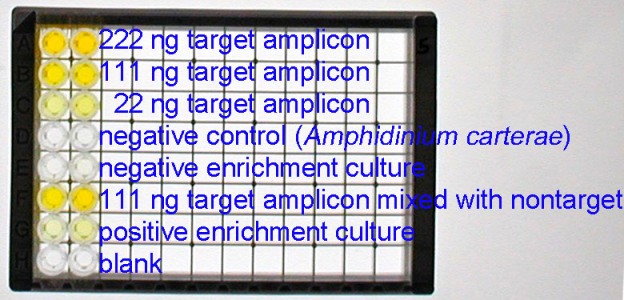Microplate DNA Hybridization Assay
 Example of a microplate assay to detect toxic dinoflagellates
Example of a microplate assay to detect toxic dinoflagellates
INTRODUCTION:
A DNA hybridization assay in microtiter plate format can be used to provide quick, colorimetric detection of a variety of organisms.
This website provides a vehicle of knowledge transfer so that end-users can adapt this technique to the molecular probes
of their choice or to provide an introduction to molecular methods for educational purposes.
Step-by-step written instructions and a video tutorial are provided.
Molecular probes for the species of interest are bound to the surface of microtiter plates.
DNA is amplified and labeled with biotin during thermal cycling, hybridized to the probe bound on the plates, and detected via HRP chemistry leading to a colorimetric reaction.
The assay gives immediate visual results, is more specific and convenient than a series of species-specific PCR reactions,
and is faster, easier and less expensive than cloning.
It is simple to add and adapt probes to the assay.
The technique conserves the amount of genomic DNA utilized, which can be critical to certain applications.
The microplate assay can allow screening of samples without the microscopic or culturing expertise normally required.
Overall, the microplate assay offers the sensitivity and specificity of molecular analysis in a convenient, adaptable, and
relatively inexpensive format.
METHOD VISUAL SUMMARY:
LEARN HOW -- A Visual Overview
METHOD ON VIDEO:
LEARN HOW -- Watch the Video
UP TO MENU
STEP-BY-STEP WRITTEN INSTRUCTIONS:
LEARN HOW -- LINK TO: Written Protocol
PUBLICATIONS/POSTERS/LINKS:
LINK TO: Publication -- "A DNA hybridization assay to identify
toxic dinoflagellates in coastal waters: detection of Karenia brevis in the Rookery Bay National Estuarine Research Reserve"
LINK TO: Poster Presentation
LINK TO: Project Bulletin on the CICEET web page
REFERENCES:
Kiesling,T., M. Diaz, A. Statzell-Tallman, and J.W. Fell (2002)
Field identification of marine yeasts using DNA hybridization macroarrays.
In: Marine Mycology:
The Organisms, Ecology and Applied Aspects.
Hyde,K. (ed). Hong Kong: Fungal Diversity Press, 69-80.
K.D. Goodwin, S.A. Cotton, G. Scorzetti, and J.W. Fell (2005)
A DNA hybridization assay to identify toxic dinoflagellates in coastal waters:
detection of Karenia Brevis in the Rookery Bay National Estuarine Research Reserve.
Harmful Algae, 4:411-422
UP TO MENU
e-mail: kelly.goodwin@noaa.gov for more info
DISCLAIMER:
This site does not endorse or recommend any commercial products, processes, or services. Brand names are included as examples only,
and their inclusion does not imply any agency endorsement. Also, if a particular brand name is not mentioned, this does not
mean or imply that the product is unsatisfactory.


